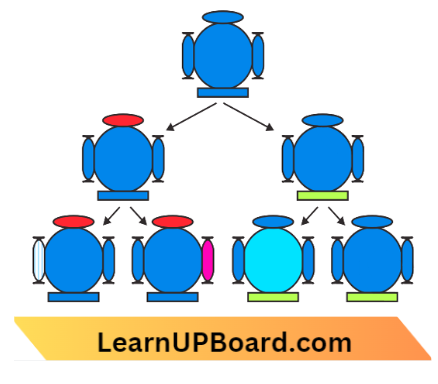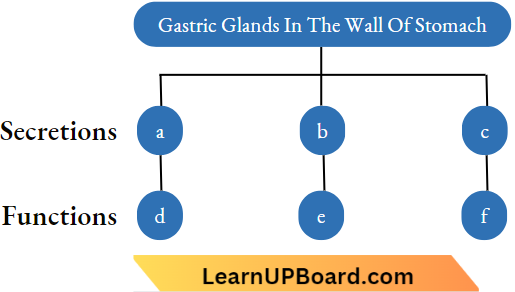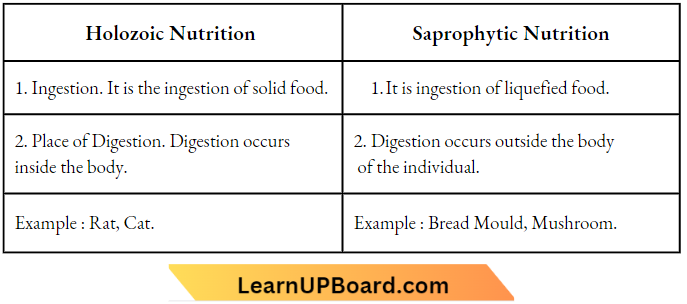Class 10 Biology Nutrition Notes
What Is Nutrition? Why Food Is Necessary For A Living Organism?
It is the process of obtaining food and its utilisation in the body for obtaining energy and body-building materials. Food is a carbon-based material substance that is broken down to yield energy, body building materials for growth, development, repair and regulatory biochemicals.
Nutrition Functions
- Body Building, Growth And Repair. Food provides materials for the synthesis of proteins and other body-building materials that are required for the maintenance, growth and repair of the body.
- Energy. Food contains energy in the chemical form. Chemical linkages are broken down to release energy which is trapped in ATP (Adenosine Triphosphate). The released energy is used in all body functions including maintenance of cellular organisation.
- Regulators. Hormones, vitamins and enzymes are products of biochemicals provided by food. They take part in regulating body functions and chemical changes including digestion, anabolism and catabolism.
- Development. It is the food which provides raw materials for progressive changes in size, shape and function of the body during the lifetime of an individual.
How Do Living Things Get Their Food? There are two methods of obtaining food, autotrophic and heterotrophic. In autotrophic nutrition, the organisms obtain inorganic raw materials (carbon dioxide, water, minerals) from the environment, pick up energy from solar radiation and synthesise organic food. The organisms performing autotrophic nutrition are called autotrophs.
class 10 excretion notes
They include green plants, cyanobacteria, some bacteria and some protists. In heterotrophic nutrition, the organisms obtain readymade food from the outside. This food is made of complex substances. They are first broken down into simpler ones by means of enzymes.
The simpler substances are picked up by living cells to build up their protoplasm and energy molecules. Organisms performing heterotrophic nutrition are called heterotrophs. They include animals, fungi, protozoans and many bacteria.
Class 10 Biology Nutrition Notes Autotrophic Nutrition
It is a mode of nutrition in which organisms build their own organic food from inorganic raw materials with the help of energy obtained from outside. The common mode of autotrophic nutrition is photosynthesis.
Photosynthesis. It is the process of formation of organic food from inorganic raw materials (CO2, H2O) with the help of sunlight inside chlorophyll-containing cells. The initial product is glucose from which other biochemicals are formed.
class 10 science notes biology
- Excess glucose is stored in the form of starch, just as glycogen is stored in our body as a source of energy. The leaf is most suitable for photosynthesis as it is flattened to receive maximum sunlight, contains abundant stomata for quick exchange of gases and a large number of vascular strands for bringing in water and taking away products of photosynthesis.
- A small amount of photosynthesis also occurs in young stems.
- The site of photosynthesis is a green plastid called chloroplast Chloroplasts occur in good numbers in both palisade and spongy parenchyma cells of leaves. Chloroplasts contain the green photosynthetic pigment called chlorophyll. Chlorophyll is specialised to absorb solar energy and convert it into chemical energy.
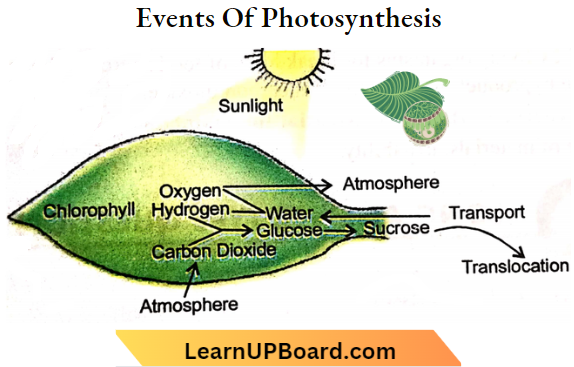
Photosynthesis Events. Three events occur in quick succession in photosynthesis,
- Absorption of light energy by chlorophyll.
- Splitting of water and conversion of light energy into chemical energy.
- Reduction of carbon dioxide to form carbohydrates and other biochemicals.
However, most desert plants do not follow this sequence. They absorb CO2 during the night when their stomata are open. The same is stored as organic acid. During the day when stomata are closed, solar energy absorbed by chlorophyll is used to synthesise organic food.
science chapter 6
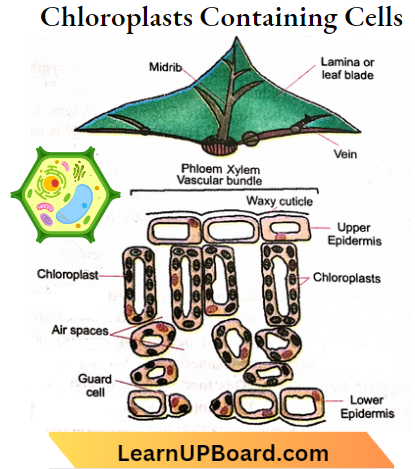
Raw Materials Of Photosynthesis
- Chlorophyll. It is green coloured photosynthetic pigment which is specialised to absorb solar energy and convert it into chemical energy. Other photosynthetic pigments, called carotenoids, also take part in absorbing solar energy. They hand over the energy to chlorophyll for chemical conversion.
- Carbon Dioxide. Land plants obtain CO2 from the air through their stomata. Stomata function as turgor-operated valves. Their guard cells curve out when they swell up on absorption of water. It creates a pore in between them. As guard cells lose water, they shrink, become straight and close the pore.
- When the stomata are open, a quick gaseous exchange occurs. It provides the required CO2, to photosynthetic cells. However, open stomata also pass out a lot of water vapours in transpiration. Transpiration stops as the stomata close. However, gaseous exchange continues to occur on a smaller scale from the surface of stem, root and even leaves.
- Water. In land plants, it is obtained from soil. The absorbed water is transported along with minerals to the photosynthetic areas through the xylem. Minerals help in the synthesis of specific biochemicals like sulphur in proteins, magnesium in chlorophyll, etc.
- Light. It is the visible part of solar radiation with a wavelength of 390-760 nm. Photosynthetically active light is 400-700 nm. Light brings about the photolysis of water and excitation of chlorophyll.
life processes
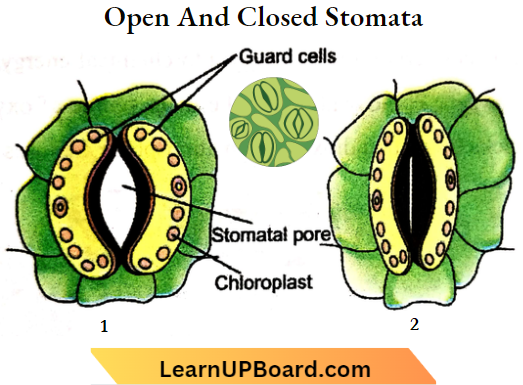
The overall equation of photosynthesis is

Photosynthesis Importance
- Food. Photosynthesis produces organic food. All the organisms depend upon this food for their survival.
- Energy. Photosynthesis converts radiant energy into chemical energy.
- Oxygen. It releases oxygen. Photosynthesis is the main source of oxygen in our environment.
- Carbon Dioxide. It picks up carbon dioxide from the atmosphere and uses the same in building organic food.
Activity 1.1 Carbon Dioxide Is Necessary For Photosynthesis
Take two potted plants. Destarch them by keeping them in perfect darkness for 2-3 days. Place the detached potted plants on glass slabs. Place a watch glass having potassium hydroxide solution near one of them. Cover both the potted plants with bell jars. Seal the edges of the bell jars with Vaseline. Place the two plants in sunlight for 2-4 hours.
process notes
Afterwards, pluck one leaf from each potted plant and test the same for starch (dipping in boiled water, in hot alcohol, in hot water again, in iodine solution and wiping off iodine with water). The leaf of a potted plant with potassium hydroxide does not show a positive starch test showing that it has not performed photosynthesis.
The leaf of the other potted plant turns bluish black indicating the presence of starch and hence photosynthesis. The only difference between the two potted plants is the absence of CO2 in the first and the presence of carbon dioxide in the second. Therefore, carbon dioxide is essential for photosynthesis.
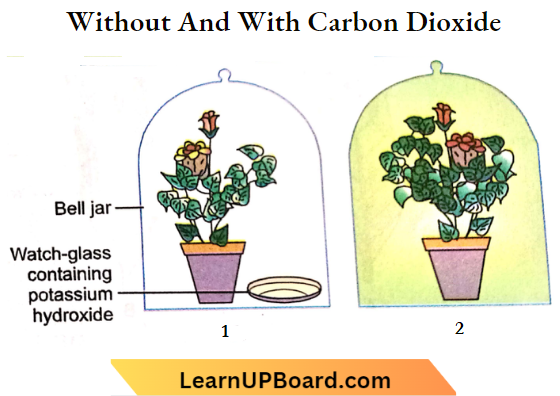
Activity 1.2 Chlorophyll Is Necessary For Photosynthesis.
Take a potted plant of Coleus, Money plant or Croton having variegated leaves. Keep it in perfect darkness for three days in order to destroy its leaves. Place the potted plant in sunlight for 2-6 hours. Pluck one variegated leaf and draw the outline of its green and non-green areas on rice paper.
Dip the leaf in boiling water for 5-10 minutes. Dip the leaf in alcohol or spirit kept at 50°- 60° C with the help of a water bath. After 3045 minutes, the leaf will become decolourised due to the dissolution of chlorophyll.
“class 10 transportation notes “
Place the decolourised leaf in hot water in order to remove alcohol and soften it. Keep the leaf in a petri dish and pour dilute iodine over it. Remove iodine and wash the leaf with water by means of a dropper. Find that the leaf has two types of patches, bluish-black and pale-coloured.
Compare it with the sketch drawn on rice paper. The bluish-black colour of starch appears where the leaf is green. The pale colour represents the previous non-green areas. As starch develops only after photosynthesis, the chlorophyll-containing areas perform photosynthesis. Therefore, chlorophyll is necessary for photosynthesis.
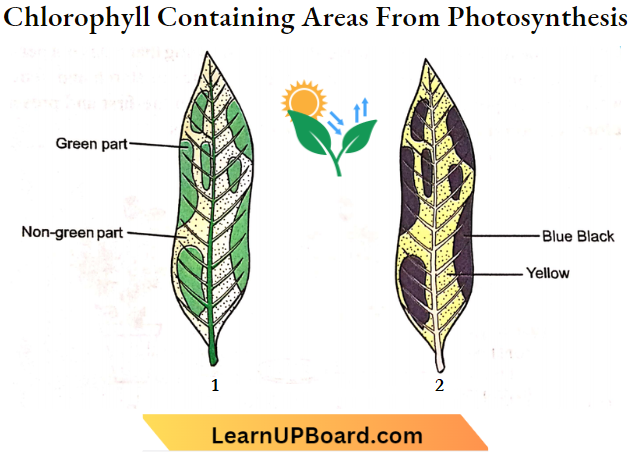
Activity 1.3 Light Is Necessary For Photosynthesis.
Destarch a potted plant by keeping it in complete darkness for 2-3 days. Fix a strip of thick black paper on the upper surface of a leaf by means of cello tape. Expose the leaf to sunlight for 2-3 hours. Pluck the leaf and remove the black paper.
biology chapter 6 class 10 notes
Test for starch (by dipping in boiled water, then in hot alcohol, in hot water again and lastly in iodine solution). The covered part of the leaf remains pale-coloured due to the absence of starch, while the rest of the leaf becomes bluish-black due to the presence of starch. As the covered part does not show photosynthesis, light is necessary for photosynthesis.
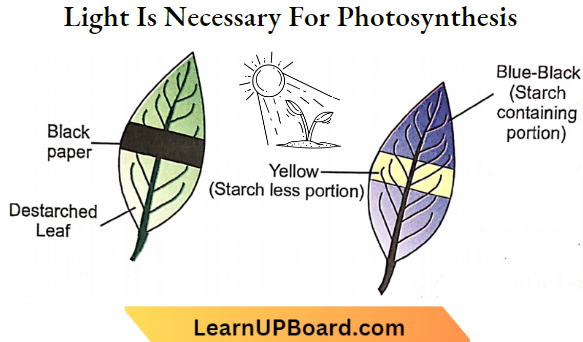
Class 10 Biology Nutrition Notes Heterotrophic Nutrition
What Is Heterotrophic Nutrition? How The Organisms Get Their Food?
It is a mode of nutrition in which an organism obtains readymade food from an outside source for both bodybuilding and the liberation of energy. Heterotrophic nutrition is of three main types— saprophytic, parasitic and holozoic.
Differences Between Autotrophic And Heterotrophic Nutrition
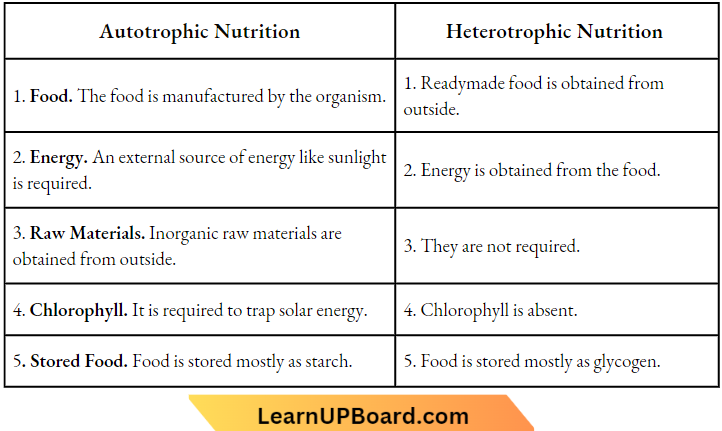
- Saprophytic Nutrition. It is obtaining nutrients from organic remains and food articles by performing external digestion. Here digestive enzymes are poured over the food particles which undergo solubilisation.
- The solubilised materials are absorbed and assimilated. The organisms performing saprophytic nutrition are called saprophytes, for example, fungi like bread mould, yeast and mushrooms, and several bacteria.
- Parasitic Nutrition. Here, a living organism called a parasite obtains food from another organism called the host. The parasite may live over the body of the host (ectoparasite, for example, leech, ticks, lice, Cuscuta or Amar Bel) or inside the body of the host (endoparasite, for example, Tapeworm, Ascaris). The parasites causing disease in the host are called pathogens.
- Holozoic Nutrition (Ingestive Nutrition). Solid pieces of food are taken in. They are digested inside the body. Herbivores feed on plants. Carnivores prey upon other animals including herbivores.
Differences Between Saprophytes And Parasites
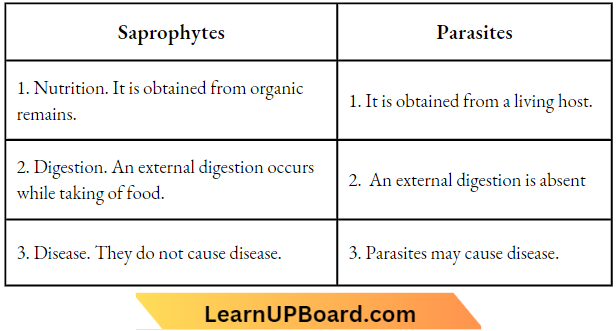
notes for biology class 10
Differences Between Photosynthetic And Holozoic Nutrition
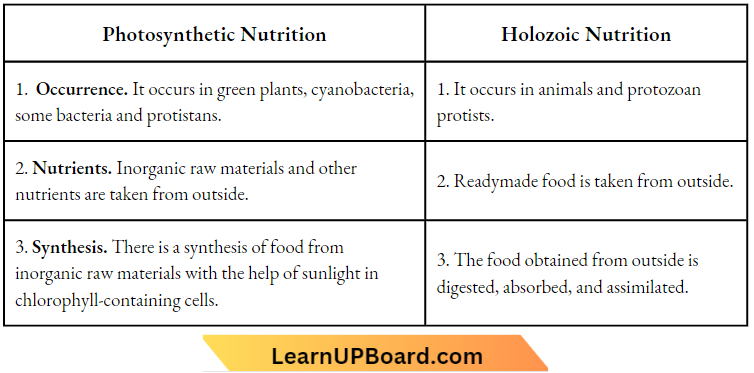
Class 10 Biology Nutrition Notes Organisms Obtain Their Nutrition
How Does The Unicellular Organism Differ From the Multicellular Organism, In Obtaining Food?
There are many methods of obtaining nutrition in holozoic organisms. They depend upon the complexity of the organisms and the mode of their feeding. In all cases, holozoic nutrition involves five steps— ingestion, digestion, absorption, assimilation and egestion.
In unicellular organisms like Amoeba food can be taken in by the entire surface. As soon as a food particle comes in contact with the cell surface, it sends out pseudopodia all around it. As the tips of pseudopodia fuse, the food particle comes to lie in a vacuole called a food vacuole.
With the help of digestive enzymes brought by lysosomes, the food particle is digested. Its soluble products pass into the surrounding cytoplasm. The insoluble ingredients contained in the vacuole rise to the surface and are thrown out.
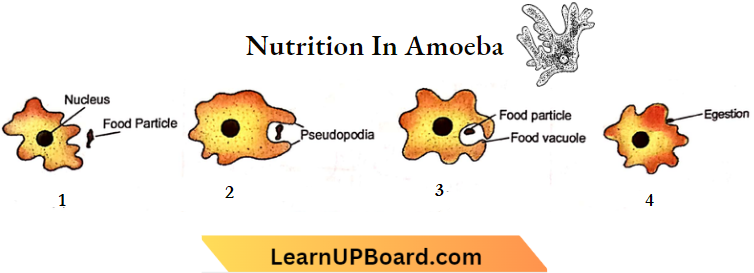
In some unicellular organisms like Paramecium, the cell has a definite shape and food is taken in through a temporary mouth or cytosome by cilia. After digestion, the digestible particles are thrown out through another temporary opening called cytotype.
In multicellular organisms, different parts of the body become specialised to perform different functions—ingestion by mouth, digestion in alimentary canal, circulation of digested food by blood and lymph, its absorption and assimilation by individual cells. The undigested part of food is thrown out of the alimentary canal in a process called egestion.
life processes notes
Class 10 Biology Nutrition Notes Nutrition In Human Beings
What Are The Different Parts Starting From Mouth To Anus?
Human beings are omnivorous with holozoic nutrition. They have a digestive system consisting of an alimentary canal and some glands attached to it, viz., salivary glands, liver and pancreas.
The alimentary canal or gut is a long tubular passageway through which food passes during its digestion and absorption. It is about 8-9 metres in length. The Alimentary canal begins at the mouth for ingestion and ends at the anus for egestion. In between the two are buccal cavity, oesophagus, stomach, small intestine and large intestine.
Mouth. It is a transverse aperture for the intake of food. The mouth is bounded by two movable sensitive lips.
Buccal Or Oral Cavity. It is enclosed between two powerful jaws. The upper jaw is fixed while the lower jaw is movable. Both the jaws bear teeth in semi-circular rows. The lower jaw also contains
- Tongue. It is a flattened, movable and protrusible structure attached posteriorly. The tongue bears taste buds. The tongue helps in moving food and cleaning teeth.
- Teeth. Human teeth are heterodont (of four types) and thecodont (partially embedded in sockets of jaw bones). Teeth are made of an ivory-like substance called dentine. The exposed parts of teeth are further covered by a shiny hard structure called enamel. The various teeth are incisors (chisel-shaped for biting), canines (dagger-shaped for tearing), premolars (cusped for grinding) and molars (cusped for crushing and grinding).
The dental formula for adult human is \(\frac{\text { One Half of Upper Jaw }}{\text { One Half of Lower Jaw }}=\mathrm{i} \frac{2}{2}, \mathrm{c} \frac{1}{1}, \mathrm{pm} \frac{2}{2}, \mathrm{~m} \frac{3}{3}=\frac{8}{8} \times 2=\frac{16}{16}=32\)
Dental Caries. They are cavities formed in teeth due to the activity of the bacteria Streptococcus mutAnswer: The bacterium feeds on food particles rich in sugar, forms plaques over teeth and secretes acids that corrode the teeth by dissolving enamel and dentine.
Brushing teeth after meals removes the plaque and does not provide space for bacteria. Otherwise, the dental caries or cavities increase in size and reach the pulp of teeth causing acute pain and falling of teeth.
Salivary Glands. Three pairs of glands pour saliva into the buccal cavity. They are parotid (below the ears), submaxillary (at the angles of the lower jaw) and sublingual (below the tongue). Saliva is mainly made of mucus and water for lubrication. It has antimicrobial enzyme lysozyme and a digestive enzyme ptyalin or salivary amylase.
- Ptyalin partially digests starch into maltose making the food sweet if kept in the mouth for a longer period.
- Food is moistened by saliva, crushed by teeth and partially digested by ptyalin. The softened food is rolled into a small ball or bolus and passes through the pharynx (common passage of respiratory and digestive tracts) into the oesophagus. The act is called swallowing.
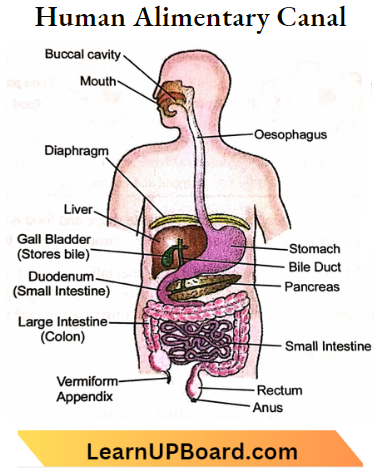
Oesophagus (Food Pipe). It is a muscular tube that connects the buccal cavity with the stomach. Its muscles undergo rhythmic contraction and relaxation to push the food forward. The phenomenon is called peristalsis. It occurs throughout the digestive tract.
Stomach. It is the J-shaped widest part of the alimentary canal which secretes a digestive juice called gastric juice. Gastric juice contains HCl, mucus and an enzyme pepsin. HCl disinfects the food and makes it acidic for the action of pepsin. Pepsin takes part in the digestion of protein.
The stomach performs churning movements which mixes food with gastric juice and breaks it into smaller particles. The semi-digested food or chyme passes into the distal end of the stomach called pylorus. It has a sphincter which opens to pass only the pulpy food into the duodenum.
Small Intestine. This is the longest part of the alimentary canal which lies coiled extensively in the abdomen. Its length is longer in herbivorous animals as their food has a larger bulk and the cellulose of their diet requires longer time for digestion. The small intestine is comparatively shorter in carnivorous animals like lions as their diet of meat has a small bulk and is easily digestible.
- In human beings, the small intestine is about 6 m in length. It is differentiated into three parts—duodenum, jejunum and ileum. The duodenum is the proximal part which receives the secretion from the liver and pancreas.
- The small intestine also possesses a large number of digestive glands (intestinal glands). Their juice is called succus entericus. The intestinal wall has numerous finger-like projections called villi. They increase the surface area of the intestine several times for rapid absorption of digested food. Further villi have a rich supply of blood vessels and a lymph vessel.
- The semi-digested food entering the duodenum from the stomach is acidic. It is neutralised and made alkaline by the secretion of a liver called bile. Bile has no digestive enzyme. Besides making the food alkaline for the action of pancreatic juice, it breaks fat into small globules.
- The process is called emulsification. It is similar to the action of soap. The emulsified fat can be easily broken down by the enzyme lipase.
Pancreatic juice contains enzymes for the breakdown of all the components of food—protein, fats, carbohydrates, nucleic acids.
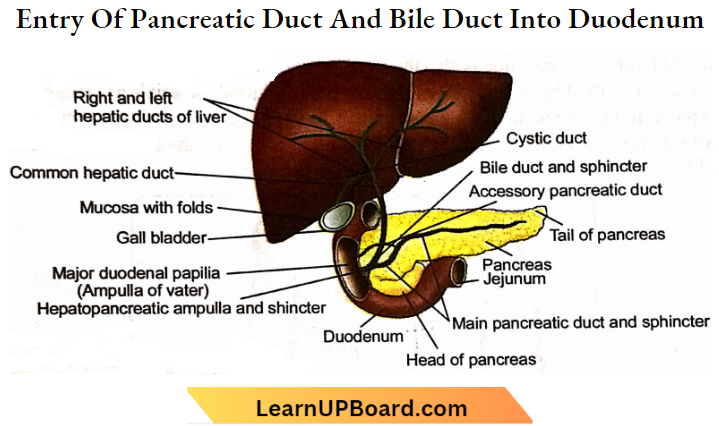
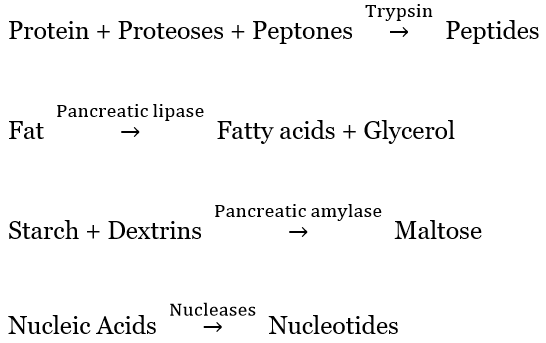
The wall of the small intestine possesses a number of digestive glands in crypts or depressions around the villi. Their secretion called succus entericus contains many types of enzymes that complete the process of digestion.
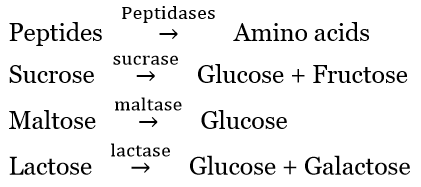
Intestinal lipase and intestinal amylase act on intact lipids and carbohydrates to completely break the same. As a result, the food contained in the small intestine becomes changed into a liquid emulsion.
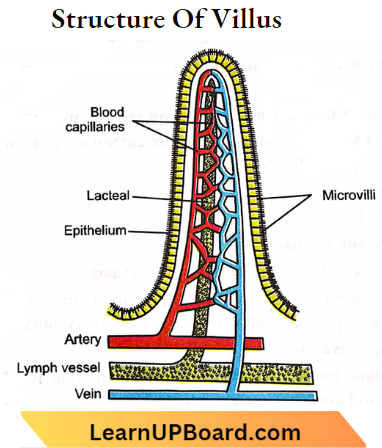
Besides the digestion of food, the small intestine is also the nite of absorption of digested food, For lids il has a large number of vascularized villi, and Fat is absorbed by the lacteals of villi. Other digested food materials are taken up by blood capillaries. The latter forms a hepatic portal vein. It lakes the absorbed food to the liver for
- Storage of extra nutrients.
- Detoxification (dioxins and
- Deamination of extra amino acids, From the liver, the blood lakes the food to all purls of the body for supply to all Individual cells, Extra fat is stored in adipose tissue.

Large Intestine. It is the hindermost part of the alimentary canal. The diameter is 4-6 cm (as compared to 3.5-4.5 cm in the small intestine) while the length is about 1.5 m. The large intestine has three parts – caecum, colon and rectum.
The caecum is a small pouch to which a small blind tube called a vermiform appendix is attached. Colon is the longest part. It is sacculated. There are three parts – ascending, transverse and descending. The slurry containing undigested matter enters it through the caecum. Water is absorbed and the undigested matter gets converted into semisolid faecal matter.
The rectum is the last part of the large intestine which is 12-15 cm in length. It opens to the outside through the anus. The feeling of defalcation occurs as faecal matter reaches the rectum. The exit is regulated by an anal sphincter.
